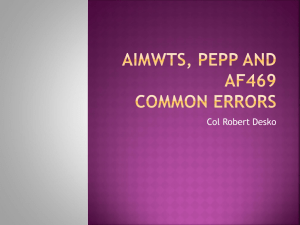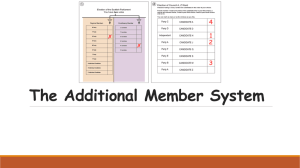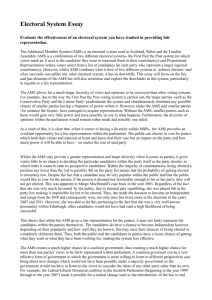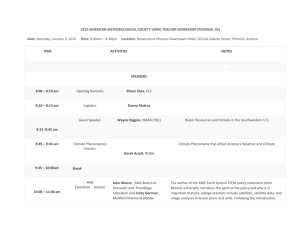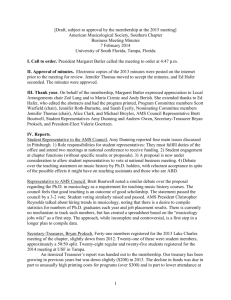Reliving Emotional Personal Memories: Affective Biases Linked to
advertisement
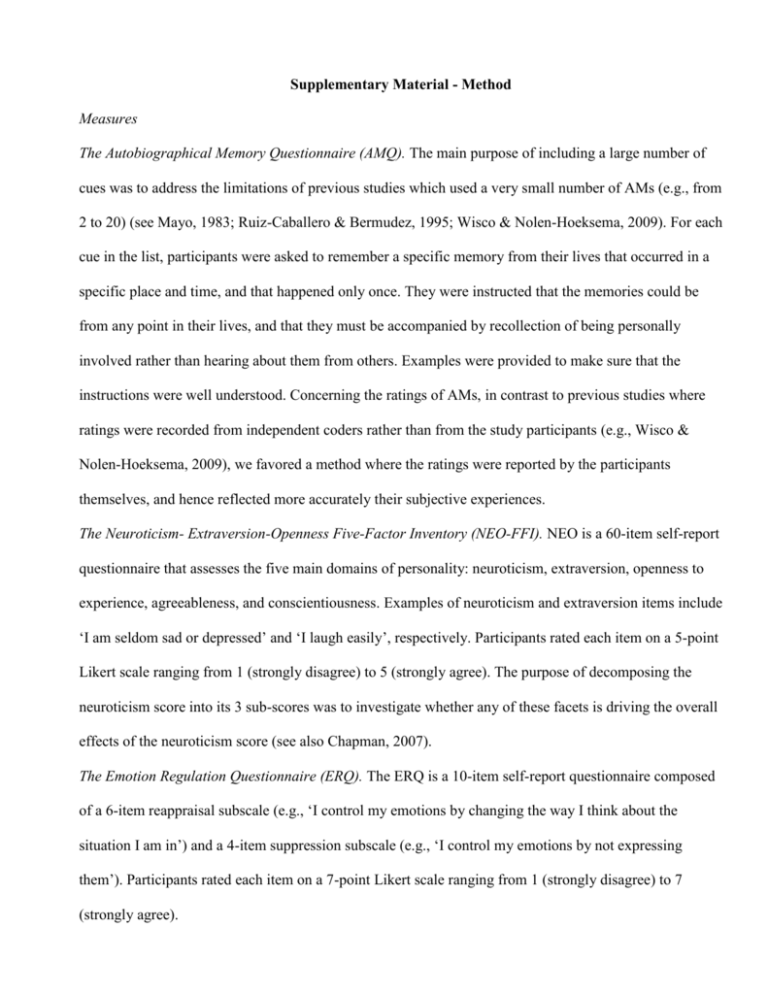
Supplementary Material - Method Measures The Autobiographical Memory Questionnaire (AMQ). The main purpose of including a large number of cues was to address the limitations of previous studies which used a very small number of AMs (e.g., from 2 to 20) (see Mayo, 1983; Ruiz-Caballero & Bermudez, 1995; Wisco & Nolen-Hoeksema, 2009). For each cue in the list, participants were asked to remember a specific memory from their lives that occurred in a specific place and time, and that happened only once. They were instructed that the memories could be from any point in their lives, and that they must be accompanied by recollection of being personally involved rather than hearing about them from others. Examples were provided to make sure that the instructions were well understood. Concerning the ratings of AMs, in contrast to previous studies where ratings were recorded from independent coders rather than from the study participants (e.g., Wisco & Nolen-Hoeksema, 2009), we favored a method where the ratings were reported by the participants themselves, and hence reflected more accurately their subjective experiences. The Neuroticism- Extraversion-Openness Five-Factor Inventory (NEO-FFI). NEO is a 60-item self-report questionnaire that assesses the five main domains of personality: neuroticism, extraversion, openness to experience, agreeableness, and conscientiousness. Examples of neuroticism and extraversion items include ‘I am seldom sad or depressed’ and ‘I laugh easily’, respectively. Participants rated each item on a 5-point Likert scale ranging from 1 (strongly disagree) to 5 (strongly agree). The purpose of decomposing the neuroticism score into its 3 sub-scores was to investigate whether any of these facets is driving the overall effects of the neuroticism score (see also Chapman, 2007). The Emotion Regulation Questionnaire (ERQ). The ERQ is a 10-item self-report questionnaire composed of a 6-item reappraisal subscale (e.g., ‘I control my emotions by changing the way I think about the situation I am in’) and a 4-item suppression subscale (e.g., ‘I control my emotions by not expressing them’). Participants rated each item on a 7-point Likert scale ranging from 1 (strongly disagree) to 7 (strongly agree). 2 The Positive and Negative Affective Schedule (PANAS-S). PANAS-S is a widely-used measure of current mood state composed by a list of 20 adjective descriptors of 10 positive (e.g., ‘interested’, ‘enthusiastic’) and 10 negative (e.g., ‘irritable’, ‘upset’) affects. Items are rated on a 5-point scale (1 = very slightly or not at all, 5 = extremely), according to how participants presently feel. Data Analyses It should be noted that we adopted the term of overall proportion of positive / negative AMs to designate the % of positive and negative AMs, calculated for each participant relative to the total number of AMs recalled. We also used the term relative proportion of positive / negative AMs to designate the % of positive and negative AMs relative to each other (i.e., calculated by subtracting the % of positive and negative AMs from each other: i.e., % Positive AMs minus % of Negative AMs and vice versa). While overall proportion is separately indexing the proportion of positive and negative AMs, the relative proportion is indexing a more direct comparison of the proportion of positive and negative AMs. T tests and ANOVAs were used to investigate sex-related differences in personality factors, affective AMs (across-groups) and emotional states, before and after AMs retrieval (within and acrossgroups). Hierarchical regression analyses (Cohen, Cohen, West, & Aiken, 2003; McFall, Geall, Fischer, Dolcos, & Dixon, in press), investigating whether sex moderates the relationship between personality measures and affective AMs , involved three-steps hierarchical regressions (moderation analyses). Each step corresponded to the entry of single variables (i.e., Step 1: personality measures; Step 2: sex; and Step 3: personality measures x sex interaction term. Correlation analyses were performed separately in women and men, to further investigate the relationship between personality measures and affective AMs, with a focus on examining potential relationships that may be present only in one sex group or may go in opposite directions women or men, and hence possibly precluding their identification with whole-group analyses. Regression-based mediator analyses (Preacher & Hayes, 2004) sought to identify: (a) independent variables predicting dependent variables, (b) independent variables predicting mediator(s), and (c) 3 independent variables and the potential mediator(s) considered together to predict the dependent variables. Investigations of the role of personality- and sex-related differences in the relationship between affective AMs and emotional states also considered emotional states recorded before recollection of AMs. Depending on whether the impact of pre-retrieval emotional state on AMs, or the impact of AMs on the post-retrieval emotional states were tested, positive and negative AMs were either the dependent or the independent variable, respectively. Specifically, to determine whether the effect of the pre emotional state (independent variable) on the recollection of affective AMs (dependent variable) is mediated by personality traits (the mediator), and whether the effect of the affective memories (independent variable in this case) on the post emotional state (dependent variable) is mediated by personality traits (the mediator), unstandartised regression coefficients and the corresponding standard errors for the regressions b and c above were tested using the Sobel test (Preacher & Hayes, 2004). Finally, to control for sex-related differences in the mediation-based analyses, the sex factor was kept constant (i.e., entered in the first step of each regression analysis). 4 Supplementary Material - Results For each of the research questions, we report a table presenting the results from the three-step multiple regression analyses (i.e., moderation analyses), which were significant at least in the first step. 1. The Role of Personality- and Sex-Related Differences in the Retrieval of Affective AMs Table S1: Hierarchical Multiple Regressions Examining the Moderation Effect of Sex on the Relationship between Personality Factors and Affective AMs. Summary of the results from the three-step hierarchical regression analyses investigating the relationship between each personality factor and affective AMs, for both the proportion of affective AMs and their characteristics. Extraversion % Pos AMs % Pos-Neg AMs Intensity Neg AMs β ∆ R2 ∆F β ∆ R2 ∆F β ∆ R2 ∆F Block 1 0.34 0.12 9.28** 0.24 0.06 4.25* 0.28 0.08 5.69* Block 2 0.01 0.00 0.00 0.13 0.02 1.24 -0.14 0.02 1.34 Block 3 0.37 0.01 0.35 0.10 0.00 0.03 0.06 0.00 0.01 Neuroticism % Neg-Pos AMs Rehearsal Pos/Neg AMs β ∆ R2 ∆F β ∆ R2 Block 1 -0.23 0.05 3.77 0.38 / 0.45 0.15 / 0.20 11.94** / 17.70** Block 2 -0.06 0.00 0.23 -0.04 / -0.04 0.00 / 0.00 0.15 / 0.13 Block 3 1.01 0.08 6.35* -0.73 / -0.99 0.04 / 0.08 3.56 / 7.30** N- Anx Rehearsal Pos/Neg AMs β ∆ R2 Block 1 0.26 / 0.33 0.07 / 0.11 5.21* / 8.39** Block 2 -0.07 / -0.06 0.00 / 0.00 0.29 / 0.26 Block 3 -0.97 / -1.11 0.10 /0.13 N- Depr Rehearsal Pos/Neg AMs ∆F 7.99** / 11.55** β ∆ R2 Block 1 0.26 / 0.28 0.06 / 0.08 4.53* / 5.96* Block 2 -0.10 / -0.11 0.01 / 0.01 0.70 / 0.82 Block 3 -0.76 / -1.21 0.07 / 0.18 5.52* / 16.31** N-SR ∆F ∆F Pers Sign Neg AMs Rehearsal Pos/Neg AMs β % Neg-Pos AMs ∆ R2 ∆F β % Neg AMs ∆ R2 ∆F Intensity Pos AMs β ∆ R2 ∆F β ∆ R2 ∆F β ∆ R2 Block 1 0.25 0.06 4.70* 0.29 0.09 6.80* 0.23 0.05 3.84 0.26 0.07 5.22* 0.40 / 0.43 0.16 / 0.18 13.03** / 15.62** Block 2 -0.05 0.00 0.14 -0.18 0.03 2.48 -0.01 0.00 0.00 0.08 0.01 0.44 -0.03 / -0.03 0.00 / 0.00 0.06 / 0.08 Block 3 0.74 0.06 4.96* 0.5 0.03 2.25 -0.23 0.01 0.43 -0.14 0.00 0.17 -0.38 / -0.48 0.02 / 0.3 ERQ-R % Pos AMs Vividness Pos/Neg AMs ∆F 1.40 / 2.31 Context Pos/Neg AMs β ∆ R2 ∆F β ∆ R2 Block 1 0.27 0.07 5.26* 0.28 / 0.31 0.08 / 0.09 6.06* / 7.28** 0.27 / 0.34 ∆F β ∆ R2 ∆F Block 2 0.02 0.00 0.03 -0.07 / -0.02 0.01 / 0.00 0.39 / 0.33 -0.07 / -0.02 0.00 / 0.00 0.31 / 0.04 Block 3 1.58 0.06 4.74* -0.00 / -0.02 0.00 / 0.00 0.00 / 0.00 -1.03 / -1.251 0.03 / 0.04 1.96 / 2.83 ERQ-S % Pos AMs 0.07 / 0.12 5.36* / 9.23** % Neg-Pos AMs β ∆ R2 ∆F β ∆ R2 ∆F Block 1 -0.21 0.05 3.27 0.25 0.07 4.76* Block 2 0.01 0.00 0.00 -0.15 0.02 1.71 Block 3 -0.14 0.00 0.12 -0.15 0.00 0.15 Note. Pos = Positive, Neg = Negative, AMs = Autobiographical Memories, N-Anx = Anxiety sub-scale from neuroticism, N-Depr = Depression sub-scale from neuroticism, N-SR = Self-Reproach sub-scale from neuroticism, ERQ-R = ERQ-Reappraisal, ERQ-S = ERQ-Suppression, Pers Sign = Personal Significance, Context = Contextual Details. * p < 0.05, ** p < 0.01 or 0.001, p < 0.05, one-tailed. 5 Figure S1. Reappraisal (ERQ-R) Predicts the Vividness of Positive (Pos) and Negative (Neg) AMs in Women only. Significant at one-tailed test 2. The Role of Personality- and Sex-Related Differences in the Relationship between Affective AMs and Emotional States Table S2: Hierarchical Multiple Regressions Examining the Moderation Effect of Sex on the Relationship among Personality Factors, Affective AMs, and Affective States. Summary of the results from the threestep hierarchical regression analyses according to the valence of the affective state: A. Findings from analyses investigating the relationship between positive pre- and post-retrieval affective states and personality traits associated with positive affect. B. Findings from analyses investigating the relationship between the negative pre- and post-retrieval affective states and personality traits and memory associated with negative affect. 6 A. Pre-Retrieval Positive State Post-Retrieval Positive State β ∆ R2 ∆F β ∆ R2 ∆F Block 1 0.47 0.22 17.19** 0.36 0.13 8.76** Block 2 0.09 0.01 0.65 0.12 0.01 0.98 Block 3 0.30 0.00 0.24 -0.79 0.02 1.47 Block 1 0.25 0.06 3.91 0.27 0.07 4.66* Block 2 0.08 0.01 0.39 0.12 0.02 0.96 Block 3 -0.32 0.00 0.17 -0.50 0.01 0.43 B. Pre-Retrieval Negative State Post-Retrieval Negative State β ∆ R2 ∆F β ∆ R2 ∆F Block 1 0.34 0.12 7.95* 0.23 0.05 3.23 Block 2 -0.04 0.00 0.10 0.22 0.04 2.83 Block 3 -0.10 0.00 0.05 0.48 0.02 1.20 Block 1 0.32 0.10 7.00* 0.22 0.05 3.18 Block 2 -0.03 0.00 0.06 0.23 0.05 3.15 Block 3 -0.26 0.01 0.44 0.43 0.02 1.24 Extraversion ERQ-R Neuroticm N- Anxiety N-Self-Reproach Block 1 0.30 0.09 5.99* 0.25 0.06 3.94 Block 2 -0.04 0.00 0.11 0.23 0.05 3.26 Block 3 0.04 0.00 0.01 0.43 0.02 1.43 Block 1 0.40 0.16 11.25** Block 2 0.24 0.06 4.10* Block 3 0.29 0.01 0.48 Block 1 -0.26 0.07 4.48* Block 2 0.16 0.03 1.67 Block 3 -0.15 0.00 0.27 % Negative AMs % Neg-Pos AMs Note. Pos = Positive, Neg = Negative, AMs = Autobiographical Memories, N-Anx = Anxiety sub-scale from neuroticism, N-Depr = Depression sub-scale from neuroticism, N-SR = Self-Reproach sub-scale from neuroticism, ERQ-R = ERQ-Reappraisal. * p < 0.05, ** p < 0.01 or 0.001, p < 0.05, one-tailed. Relationships among Personality Factors, Recollection of Affective AMs and Pre-Retrieval Emotional States Analyses focusing on the impact of pre-retrieval emotional state on recollection of affective AMs, revealed that extraversion also had a mediating effect on the relationship between positive pre-retrieval state and the proportion of positive AMs (see Figure S2); negative pre-retrieval state did not affect the proportion of negative AMs (R = 0.19, p > 0.14) (see Table S3). 7 Figure S2. Extraversion Mediates the Relationships between Positive Pre-Retrieval State and Recollection of Positive AMs. * p < 0.05 or p < 0.01. Table S3. Averages, Standard Deviations (SDs), and Correlations among the Pre-Retrieval Affective States, Affective AMs, and Personality Traits. Pre-Retrieval State All (n = 62) PANAS-S Positive Mean SD 28.97 6.43 PANAS-S Negative 13.92 % Pos AMs 4.12 % Pos-Neg AMs % Neg AMs Extraversion Neuroticism N-Anx N-Depr N-SR ERQ-R ERQ-S .1083 .0461 .1063 .4719** -.2374 -.2185 -.3173** -.1350 .2475* -.1382 -.0698 -.1629 .1894 .0363 .3421** .3232* .1932 .3012* -.2296 .1726 Women (n = 31) PANAS-S Positive PANAS-S Negative Mean SD 28.71 6.37 14.42 3.86 .2081 .1510 .0507 .3662* -.2545 -.3072 -.2653 -.0987 .3428 -.0168 -.1651 -.1587 .0271 -.0459 .3990* .4164* .4074* .2934 -.1867 .2205 .0531 -.0303 .1758 .5704** -.2152 -.1249 -.3724* -.1597 .1512 -.2892 -.0282 -.1578 .2815 .0723 .2533 .2006 .2704 -.3458 .1868 Men (n = 31) PANAS-S Positive PANAS-S Negative Mean SD 29.23 6.59 13.42 4.37 -.0450 Note. Pos = Positive, Neg = Negative, AMs = Autobiographical Memories, N-Anx = Anxiety sub-scale from neuroticism, N-Depr = Depression sub-scale from neuroticism, N-SR = Self-Reproach sub-scale from neuroticism, ERQ-R = ERQ-Reappraisal, ERQ-S = ERQ-Suppression. Purple italic and underlined = results in both women and men, Red underlined = results driven by women, Blue italic = results driven by men. * p < 0.05, ** p < 0.01 or 0.001, p < 0.05, one-tailed. Analyses focusing on the relationship between personality traits and pre-retrieval emotional states revealed that extraversion was positively correlated with the positive pre-retrieval state (R = 0.47, p < 0.001) and neuroticism was also positively correlated with the negative pre-retrieval state (R = 0.34, p < 0.01) (see Table S3). While moderation analysis did not revealed a significant neuroticism 8 x sex interaction (see Table S2), within-sex group correlations revealed that the depression sub-score of neuroticism was significantly correlated with the negative pre-retrieval state only in women (R = 0.41 for women vs. R = -0.05 for men) (see Figure S3), which probably prevented identification of significant effects at the level of the whole group. Figure S3. Depression Sub-Score of Neuroticism (NEO-D) Predicts Negative Pre-Retrieval State only in Women. Post-Retrieval Changes in Positive and Negative Mood A 3-way ANOVA examining changes in positive vs. negative states before and after AM recollection in women and men did not revealed a significant valence (positive vs. negative) x moment (pre vs. post) x sex (women vs. men) interaction (F (1, 60) = 0.49, p > 0.48). However, they revealed a significant valence (positive vs. negative) x moment (pre vs. post) interaction (F (1, 60) = 10.07, p < 0.01), which was due to a greater reduction in positive post-retrieval mood than in the negative post-retrieval mood (p < 0.0001 vs. p < 0.05).


